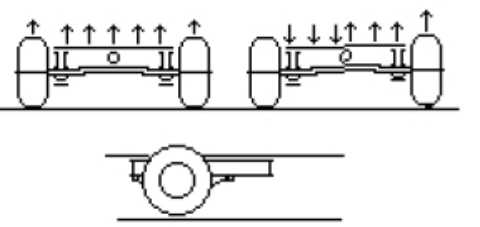VAC E-mail List Archive
The Vintage Airstream E-mail List
Archive Files
[Date Prev][Date Next][Thread Prev][Thread Next][Date Index][Thread Index]
[VAC] Re: Expanded question '48 Trailwind 'Track' Measurement w/illustration
I've expanded this question re: the original axle-length for the 1948 19'
'Trailwind' (It would probably be the same axle used on the post-war
'Clipper')...
I've got the Trailwind shell up on blocks, and i've rolled the 'truck'
back under it, and blocked the main frame 'pipe' up into relative position,
so
that what i have now is a real-life 'exploded view' of a '48 Trailwind,
minus cross-members and floor (and interior). I've 'braced' the shell with
couple of 80" 2x4" spreaders.
Something didn't look 'right'. When I bought the trailer, i was told that
the axle/wheels/brakes had been replaced a couple of years back; the 'truck'
rails and suspension (leaf-springs) are original. Wheels are new(er) steel
15", 5x5.5 bolt pattern. Now to my question:
What was the length of the original axle? That is to say, from hub-to-hub,
or the centerline of each tire?
{}---------{}=?
The replacement axle appears to be a couple of inches shorter than it could
be, and made more so by the camber-bend to it.
So - do people think that 'Wider is Better'? Remember, this is a
pipe-frame. The truck-rails were essentially independent, rendering the
trailer's suspension as 'independent', as well. Hence the flexion of the
floor on both the longintudinal ('pipe', or 'keel') and latitudinal axes is
restricted only by the aluminum sheet-metal 'I beams, only two of which are
attached to the fore and aft of the truck's frame-rails.
(see illustration below/attached)
To illustrate further, if one side the trailer were to be towed over a berm,
or a rock, or tree-root, the aluminum I-beam cross-pieces (not illustrated)
would actually facilitate the flexing, by concentrating the torsion along
each 'beam', through the floor.
By comparison, a 'ladder frame' will spread not only the load, but reduce
the flexion of the floor.
The cambered axle/wheels mitigates this only very slightly, but the effects
of the flexing of the floor are cumulative and progressive, so that only
small effects and time will pretty much result in what i've found here.
Incidentally, my ongoing forensic investigation into this trailer's past
seems to indicate that the streetside tire must have blown, and the
resultant damage to the streetside wheel-well and water-heater led to the
eventual explosion and fire which took out the water-heater.
Tuna
WBCCI#8862, VAC
Reno, NV


